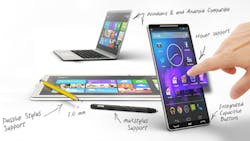Touch Controllers Handle Large Screens And Buttons
Atmel’s maXTouch mXT106xT2 handles multitouch chores for screens from 1.5-in to 15.6-in. It also has integrated capacitive button support (Fig. 1). This integration allows a single chip to handle input support for tablets and smartphones eliminating additional external components from the bill-of-materials. It will easily handle multitouch chores for Windows 8 and Android devices.
Related Articles
- Chipworks Analysis: Atmel’s MXT 540E Touch-Screen Controller
- Multitouch Sensor Brings Flexibility To Design
- Single-Sensor Solution Provides Touch And Stylus
The chips use mutual and self capacitance and they can also handle moisture and glove support not found in many multitouch controllers. They can handle a passive stylus with 256 pressure levels and a tip size of only 1-mm. This is at a 120 Hz scan rate providing fast feedback via the on-chip, 32-bit microcontroller.
The mXT1068T2 adds support for 1-mm active stylus support and it has a 25-mm detect range allowing it to provide hover detection up to 20-mm.
The chip’s 12-channel, peripheral touch controller (PTC) handles up to a dozen capacitive touch buttons without using up the X/Y lines used for the multitouch screen support. This is typically done with an additional chip or having the microcontroller use I/O interfaces that are not specially designed for touch support. Atmel’s solution has an integrated hardware oversampling and an improved front-end and integrator to improve noise immunity.
The chips are available with 114-ball HDI (high density interconnect) UFBGA (7- by 5- by 0.6-mm) with a 0.5-mm pitch or a non-HDI 117-ball UFBGA (9.5- by 7- by 0.65-mm) with a 0.65mm pitch. There is also an on-chip voltage tripler that delivers up to 9.9 V with no external regulators required.
About the Author
William G. Wong
Senior Content Director - Electronic Design and Microwaves & RF
I am Editor of Electronic Design focusing on embedded, software, and systems. As Senior Content Director, I also manage Microwaves & RF and I work with a great team of editors to provide engineers, programmers, developers and technical managers with interesting and useful articles and videos on a regular basis. Check out our free newsletters to see the latest content.
You can send press releases for new products for possible coverage on the website. I am also interested in receiving contributed articles for publishing on our website. Use our template and send to me along with a signed release form.
Check out my blog, AltEmbedded on Electronic Design, as well as his latest articles on this site that are listed below.
You can visit my social media via these links:
- AltEmbedded on Electronic Design
- Bill Wong on Facebook
- @AltEmbedded on Twitter
- Bill Wong on LinkedIn
I earned a Bachelor of Electrical Engineering at the Georgia Institute of Technology and a Masters in Computer Science from Rutgers University. I still do a bit of programming using everything from C and C++ to Rust and Ada/SPARK. I do a bit of PHP programming for Drupal websites. I have posted a few Drupal modules.
I still get a hand on software and electronic hardware. Some of this can be found on our Kit Close-Up video series. You can also see me on many of our TechXchange Talk videos. I am interested in a range of projects from robotics to artificial intelligence.


